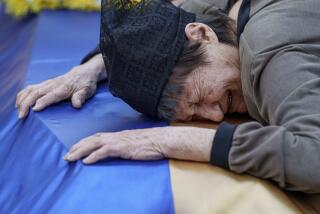Serbs Violate ‘No-Fly’ Zone in Bosnia : Balkans: Rebels in Croatia, showing no fear of NATO, reportedly use helicopters to resupply troops near Bihac.
- Share via
SARAJEVO, Bosnia-Herzegovina — Resuming a tactic that two months ago provoked NATO airstrikes, Serbian rebels in Croatia have been conducting helicopter resupply missions to front-line troops around Bihac in violation of the “no-fly” zone over Bosnia-Herzegovina, a U.N. official said Wednesday.
The sorties suggest that the nationalist rebels no longer fear any enforcement of the alliance edict. And neither the North Atlantic Treaty Organization nor the U.N. Protection Force, or UNPROFOR, moved to deter the rebel choppers as they penetrated the NATO air cap as many as 20 times Tuesday.
“We presume these helicopters are flying from Udbina,” U.N. spokesman Paul Risley said, referring to a rebel air base in Serb-occupied Croatia that was bombed by NATO on Nov. 21.
Risley said the helicopters were seen ferrying support to Bosnian Serb and Croatian Serb positions just west of Bihac, one of six U.N.-designated “safe areas” for Bosnia-Herzegovina’s endangered civilians.
Bosnian Serb gunmen were also reinforcing positions around the safe area of Srebrenica after encroaching on that U.N.-protected enclave over the weekend, U.N. military spokesman Lt. Col. Gary Coward said.
The rebels advanced about a mile into the safe area and have moved tanks and other heavy artillery to protect the territory seized in violation of a nearly 3-week-old truce, Coward said. He said the artillery movements included two long-range mobile guns aimed at the center of the safe area, which provides crude refuge to more than 40,000 people.
The Serbian buildup and incursion into Srebrenica, scene of recurring rebel offensives for the past two years, have stirred fears of another impending attack, as similar tactics were observed prior to April’s deadly bombardment of the Gorazde enclave and the ongoing campaign against Bihac, an enclave purportedly protected by the United Nations.
U.N. Security Council resolutions in the spring of 1993 designated Sarajevo, Gorazde, Srebrenica, Bihac, Zepa and Tuzla as safe areas, where Bosnian civilians are to be protected by “all available means,” including NATO air power.
Token NATO bombing raids were waged twice during the Serbian offensive against Gorazde, and a handful of other largely symbolic airstrikes were launched against advancing rebel artillery around Sarajevo and Bihac late last year.
Western military officials have since renounced the use of air power as ineffective in deterring the rebels.
U.N. officials have refrained from calling in NATO jets for fear of Serbian retaliation against the 24,000 peacekeeping troops deployed in Bosnia-Herzegovina.
NATO commanders are also reluctant to intervene further because of dozens of surface-to-air missile batteries the Serbs have trained on alliance aircraft during patrols over Bosnia-Herzegovina.
In other signs that the four-month truce stemming from former President Jimmy Carter’s December peace mission may be fraying, Bosnian government forces have been blocking U.N. troops around Tuzla airport for a week in protest of the mission’s stationing of a Serbian liaison officer at the U.N. headquarters there.
The government official responsible for relations with the U.N. mission, Hasan Muratovic, informed U.N. officials earlier this week that the government would retake control of Tuzla airport from the peacekeepers on Feb. 1 unless the mission reopens the facility to humanitarian aid flights for the nearly 1 million Bosnians in the Tuzla area.
On Tuesday, a young boy was shot in the head while sledding in Sarajevo’s first civilian sniping injury since the Carter cease-fire took effect.
More to Read
Sign up for Essential California
The most important California stories and recommendations in your inbox every morning.
You may occasionally receive promotional content from the Los Angeles Times.














